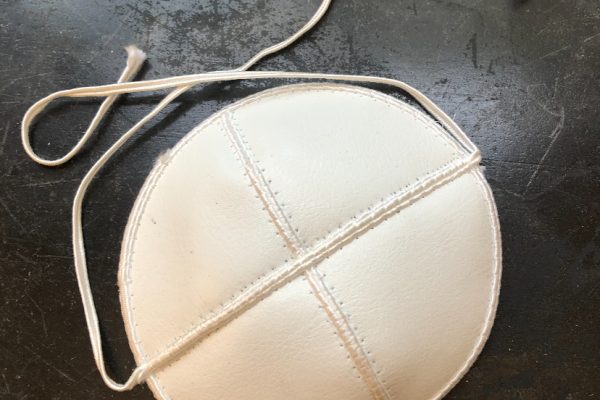How might we mark the moment of birth and coming into Jewish covenant without focusing on the gender and genitals of an infant? I realized there is one such moment immediately after birth, that like brit milah involves cutting, blood, and clamps, but without the focus on genitalia: the severing of an umbilical cord from the placenta to create a baby’s navel. In many, but not all cases, neither the baby nor the parent experience pain in the cutting of the umbilical cord.
This moment of physical separation occurs as the culmination of one life’s most transformative and sacred dramas. Cutting the umbilical cord is the first experience of individuation of an infant into consciousness, after leaving the “murmuring deep” and mayyim hayyim (living waters) of the womb. During pregnancy, the birthing parent’s womb (rekhem רֶחֶם, related to rakhamim – compassion) is the center of the fetus’s universe, the placenta their axis mundi for their existence in utero.
Interestingly, the Hebrew word for navel is טַבּוּר, tabur, which means “center.” Indeed, the navel is the center of an infant’s belly, a permanent reminder of each person’s connection to their birth parent, and a residual memory of that mysterious time before emerging into consciousness.
Here is a blessing, with multiple Hebrew options for invoking the sacred, for the cutting of an umbilical cord shortly after birthing a baby. Given that it’s not always possible to say a blessing in the sometimes chaotic moment after birth, I’ve also created a brief ritual for a public welcoming and naming ceremony after a birth. This ritual weaves a symbolic umbilical cord of red, blue or purple yarn (to echo the colors of a cord) and deploys the ancient practice of anointing the baby’s navel with oil.
The following blessing and ritual can also provide a complement to any covenantal welcoming and naming, whether a simkhat/zeved bat, brit milah, or gender-neutral ceremony.
Blessings for cutting an umbilical cord
Feminine Hebrew: Berukhah at Yah, Shekhinah, ma’ayan ha-rakhamim, she’yotzeret et ha’neshamah ve’tabur ha’hayyim.
Blessed is Yah, the in-dwelling Wellspring of Compassion, who creates the soul and the navel/center of life.
Masculine Hebrew: Barukh atah Adonai, eloheinu ma’ayan ha-rakhamim, she’yotzer et ha’neshamah ve’tabur ha’hayyim.
Blessed is Adonai, our sacred Wellspring of Compassion, who creates the soul and the navel/center of life.
Gender-neutral Hebrew: Nevarekh et ma’ayan ha-rakhamim, she’yotzreh* et ha’neshamah ve’tabur ha’hayyim.
We bless the Wellspring of Compassion, who creates the soul and the navel/center of life.
Ritual for remembering the umbilical cord and anointing a baby’s navel with oil
This ritual uses yarn and oil to offer blessings of love and protection, and to welcome a baby into their sacred community. It can be incorporated into the existing structure of a simkhat bat or brit milah. The yarn evokes the umbilical cord – the connective tissue that nourished the baby in utero and was cut after emerging into the world. Anointing with oil is an ancient Jewish way of marking a person or a place as sacred. In Genesis, Jacob anoints a stone with oil after a transformative dream in which the Divine source promised generations of descendants a blessing of protection. In Exodus, the Divine instructs Moses to anoint his brother Aaron and his sons, to deploy them as priests in sacred service. David was anointed by Samuel as recognition of his future leadership.
While singing a wordless melody (perhaps Psalm 23, melody by Rabbi Shefa Gold, Kosi revaya, “My cup overflows, I give thanks for the unknown blessings already on their way”), the parents unspool a skein of yarn that is passed from person to person in a welcoming circle of loved ones. When everyone is holding onto the yarn, the last person gives the skein back to the parents. If you run out of yarn, that’s okay! The parents then cut the cord from the skein, take the very end of the yarn, dip the end into fragrant oil and offer this promise while gently anointing the baby’s navel.
From Genesis 28:15
וְהִנֵּ֨ה אָנֹכִ֜י עִמָּ֗ךְ וּשְׁמַרְתִּ֙יךָ֙ בְּכֹ֣ל אֲשֶׁר־תֵּלֵ֔ךְ
Ve’hinei anokhi imakh u’sh’martikha b’khol asher teylekh.
Remember, I am with you: I will protect you wherever you go …
Blessing for anointing the baby’s navel, in Hebrew feminine and gender-neutral blessing language:
Feminine Hebrew: Berukhah at Yah, Shekhinah, ma’ayan ha-rakhamim, she’yotzeret et ha’neshamah ve’tabur ha’hayyim.
Blessed is Yah, the in-dwelling Wellspring of Compassion, who creates the soul and the navel/center of life.
Masculine Hebrew: Barukh atah Adonai, eloheinu ma’ayan ha-rakhamim, she’yotzer et ha’neshamah ve’tabur ha’hayyim.
Blessed is Adonai, our sacred Wellspring of Compassion, who creates the soul and the navel/center of life.
Gender-neutral Hebrew: Nevarekh et ma’ayan ha-rakhamim, she’she’yotzreh* et ha’neshamah ve’tabur ha’hayyim.
We bless the Wellspring of Compassion, who creates the soul and the navel/center of life.
Everyone says together: We bless you and anoint you to celebrate your emergence into the world. With this oil, you are sacred to us as a beloved new soul in our community. May you feel loved, nourished, and protected by our family and this community, just as your umbilical cord nurtured and nourished you in the womb. Amen!
* Yotzreh is a gender-neutral variation of the gendered Hebrew verbs yotzer/yotzeret. Learn more at the Nonbinary Hebrew Project: https://www.nonbinaryhebrew.com/.
Resources:












